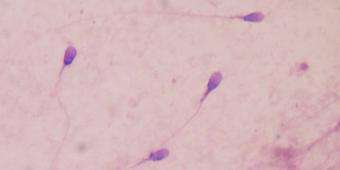More sperm cells may be needed to overcome high mortality rate

It's one of the true miracles of life, that moment when hundreds of little sperm make it all the way to an unfertilized egg and one breaches its walls. But what of all those other spermatozoa, the hundreds of millions of little guys that never make anything of themselves, that never fertilize an egg?
Why are they even there?
Perhaps, explains SFI Professor Sidney Redner, because sperm don't live forever. In fact, he says, "sperm are moving through an incredibly hostile environment," and the best way to compensate might be sending out a quarter-billion-strong search party to look for an egg.
Redner, a physicist, had been interested in so-called "search problems" for a while, he says, when he came across a research paper that asked a simple question: why so many sperm?
"The title and qualitative presentation piqued my interest," Redner says, so he and fellow physicist Baruch Meerson (Racah Institute of Physics, Hebrew University of Jerusalem) decided to probe the matter quantitatively. Starting from a simple diffusion model, in which abstract "searchers" start from one point on a line and spread out until one reaches a target, they looked at two cases: one where the searchers lived forever and one where they didn't.
Though the model is obviously a "caricature" of the process of fertilization, Redner says, it did yield some intriguing conclusions. First, immortal searchers don't gain much by arriving in massive numbers. Changing from one million to two million searchers, for example, reduces the search time only by about 5 percent.
Mortal searchers are another matter. When the mortality is sufficiently high, it is a lucky sperm that makes it, Redner says. In other words, if sperm don't live very long, the probability that any individual sperm gets lucky is very low.
Fortunately, there's a way to compensate: increase the sperm count—a lot. The number needed for a decent shot at fertilization grows exponentially with the mortality rate. That may help explain why it takes 250 million sperm, each with a lifetime of a few days, just to have decent odds of fertilizing an egg.
The study is published in Physical Review Letters.
More information: "Mortality, Redundancy, and Diversity in Stochastic Search." dx.doi.org/10.1103/PhysRevLett.114.198101
Journal information: Physical Review Letters
Provided by Santa Fe Institute



















